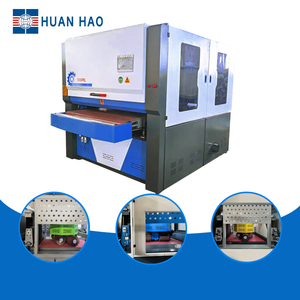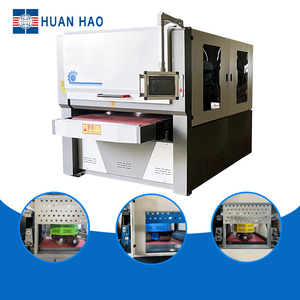
All categories
Featured selections
Trade Assurance
Buyer Central
Help Center
Get the app
Become a supplier

(107804 products available)














The automatic polishing machine for rotary tables comes in multiple types. Each type will be suited for distinct applications. These machines also vary in features, materials, and specifications.
These types of machines apply polishing using a single polishing head. This leads to the achievement of the desired polishing. This comes with excellent precision on a rotating workpiece. These machines are often employed for polishing small to medium-sized parts. This is an evident choice for those requiring fine finishes.
A multi-head polishing machine comes with several polishing heads. It allows simultaneous polishing of multiple surfaces. This increases productivity while maintaining good quality. In industries where the demand is high. At the same time, various components require polishing, multi-head machines work best.
Just like other CNC machines, CNC polishing machines guarantee high accuracy. These come in the definition of polishing patterns and parameters through computer programming. This makes it ideal for complex geometries and intricate designs. In industries requiring signature consistency in the polishing process, CNC-controlled machines are essential.
These machines use an orbital motion for polishing. It gives a better finish without the risk of over-polishing. Orbital machines are very useful in achieving uniform polishing on curved or delicate surfaces. They are commonly used in the automotive and aerospace industries.
These polishing machines use vibratory motion. It helps to polish parts in bulk. It is efficient for mass finishing. This is especially for components that can be placed in a vibratory bowl. Such machines are popular in operations that require economical and quick polishing solutions.
Generators and turbochargers in the automotive industry require polishing. This is to ensure proper fluid dynamics and aesthetic surface finishes. The automatic polishing machines enhance the efficiency and consistency of polishing critical engine components. This leads to improved performance and reduced wear.
Rotary table polishing machines are also widely used in the aerospace sector. Here, they polish components like engine parts, valves, and turbine blades. Polishing will reduce friction and enhance performance. Additionally, polishing usually minimizes weight and improves component durability.
The medical industry relies on polishing machines. Polishing will ensure that devices are polished to meet stringent hygiene and safety standards. Things like implants, surgical tools, and diagnostic equipment need polishing. In this case, the polishing machines ensure surface finishes are smooth enough to avoid harboring bacteria.
In the metalworking industry, the machine is used to enhance the quality of processed metals. This includes finished machined components, castings, or metal fabrications. Polishing also improves the aesthetic appeal of the metal surfaces. In addition, it enhances the metal's resistance to corrosion, thus increasing its lifetime.
Precious and semi-precious materials used in jewelry require polishing. Polishing will improve the luster of these items. For example, rotary table polishing machines in this industry will provide uniform polishing across multiple pieces. This increases productivity. Also, it meets the high-quality standards of the jewelry market.
Components like housings, casings, and connectors in the electronics industry need polishing. Polishing will improve the look and feel of the final products. Moreover, polishing in this industry usually acts as a preparation step. It will enhance the attachment of coatings or finishes while boosting corrosion resistance.
In the home appliances sector, polishing machines are used to enhance the finish of various metal and plastic components. Polishing, in this case, improves the appliance's visual appeal and performance. Polished components will be more resistant to fingerprints, smudges, and other forms of wear.
Rotary table design
This design enables the rotation of workpieces during the polishing process. This ensures even polishing across all exposed surfaces. In addition, most tables are adjustable. It allows users to set the angle of rotation according to the desired polishing results.
Multiple polishing heads
These machines sometimes come with multiple polishing heads. They allow concurrent polishing of different surfaces. This significantly boosts productivity, especially in mass production settings. The number of heads will vary depending on the machine's complexity and intended use.
CNC control
CNC control in the polishing machine offers a high level of precision. It lets operators program polishing paths, speeds, and durations. The control system also enables fine adjustments for different materials and designs. This enhances its application range from simple to highly detailed components.
Automated loading and unloading
This automated loading and unloading enhances the machine's efficiency. It reduces the need for manual intervention between cycles. Often, these machines are fitted with robotic arms or conveyors for loading and unloading components. This increases productivity by minimizing downtime.
Polishing parameters
Standard polishing parameters on the machine include speed control, torque adjustment, and pressure regulation. These parameters provide flexibility based on the task at hand. Good parameters ensure users achieve the desired finish without damaging the workpiece. Proper parameters will also adapt to different materials like metals, plastics, and ceramics.
The machine's installation location should have a sturdy, level, and vibration-free foundation. This will enhance stability. Users should also ensure there is enough space around the machine for easy access and maintenance. Additionally, it should be adequate for the polishing process's movement and operation.
Users should connect the machine to the appropriate power supply. Ensure the power supply meets the machine's voltage and current specifications. The supplied power should have the required electrical safety measures. This includes surge protectors and circuit breakers. They should also connect the machine to the facility's main electrical panel as per the required amperage.
Like other machines, these polishing machines will require water and compressed air to run for cooling and polishing. The machine should be connected to the facility's water supply and ensure consistent pressure and flow rate. Users should attach a compressed air source to the machine and ensure the air is dry and clean.
Users should install the rotary table securely on the given foundation. Level the table using adjustable feet or shims. Mount the workholding fixtures or adapters on the table to secure the workpieces during polishing. Ensure the fixtures are balanced and tight to prevent vibrations or movement.
Users should set up the machine's control panel and connect all sensors, motors, and other electronic components. Then, program the desired polishing parameters in the CNC control system. They should also run test cycles to verify the proper execution of the polishing operations.
Polishing preparation
Users should begin by cleaning the workpieces before polishing to remove any debris or contaminants. Check whether the workpiece surface is smooth and free from visible defects. Any major imperfections will require addressing before starting the polishing process. Choose the right polishing material depending on the workpiece material and desired finish.
Setup
Securely mount the required polishing tool on the rotary table. Each tooling will have its specification, so ensure they are compatible. Adjust the table height and angle to ensure the polishing tool and workpiece are in proper contact.
Loading workpieces
Load the workpieces onto the fixtures or the workholding area. Ensure they are securely clamped or fixed to avoid movement during polishing. Balance the load as much as possible for steady rotation.
CNC programming
Using the CNC control panel, enter the required polishing parameters. This includes polishing speed, duration, and pressure. Set the polishing path if the machine is equipped with a CNC. Make sure the paths are within the limits of the workpiece dimensions.
Running the machine
After preparing the machine, start a test run without the polishing compound. This will enable users to check for any irregularities in the rotation or tool movement. Once everything is in place, start the polishing process. While the machine is running, monitor the parameters to ensure they are at the optimum level.
The emergency stop button, like any other CNC machine, will immediately halt all machine operations. It is usually located on the front of the machine. In critical situations, this button is accessed easily for all operators. The overall impact will be a reduced risk of accidents and further damage to the machine or the workpieces.
These are important to prevent unauthorized access to moving parts of the machine. These covers and guards usually enclose dangerous areas like rotating tables or polishing heads. It helps avoid accidents by minimizing contact with these hazardous zones. This allows the operators to work with an ensured safe environment.
This kind of protection constantly monitors the machine's load on its motors and other components. It will not allow the machine to operate beyond these limits. Doing so would trigger an alarm and shut down certain operations. This prevents damage to the machine by ensuring its long-term reliability and performance.
Heat sensors on the machine constantly track the temperature of critical components like motors, polishing heads, and the rotary table. If these components reach dangerous temperatures, the sensors will trigger warnings or shut down the machine. This prevents overheating and ensures several machine components are protected from wear and tear.
These sensors, while installed, will be activated in case of unusually high vibration levels. High vibrations reduce machine accuracy and its potential harm. These sensors help by shutting down the operations whenever vibrations reach a particular threshold. The sensors ensure the specific movement has been maintained during polishing for effective results.
The automatic shut-off feature will help in stopping machine operations after completing a set cycle or reaching a certain condition. This reduces the risk of over-polishing or running the machine without supervision. In turn, the feature also contributes to reduced energy consumption, which is environmentally good.
This kind of monitoring has sensors that detect the level and consistency of the polishing compound. When the supply runs low or the compound becomes contaminated, the sensors send alerts to the operator. This ensures users always have an adequate supply of a good compound, thus maintaining safety and high-quality standards during operations.
A1.The main factors affecting the machine's autotuning are: rotary table speed, polishing pressure, and duration of polishing. Proper autotuning of these factors optimally finishes the workpiece. On the other hand, improper tuning will either damage the workpiece or underfinish it.
A2.The machine's service frequency will depend on how often it is used. In heavy use cases, the machine is serviced once a month, while light use cases can extend it to every three months. Regular maintenance will always ensure the machine is in optimal polishing condition at all times.
A3.Yes, it is crucial for personnel to receive adequate training in operating and maintaining polishing machines. These machines have complex controls and features. Proper training ensures the operators work safely, efficiently, and with a reduced risk of causing accidents or damaging the equipment while achieving the desired polishing results.
A4.Yes, the machine can finish various materials as long as its polishing parameters are compatible with the given material. Refer to the manufacturer's guidelines to adjust the polishing compound, speed, and pressure for underlying material compatibility. This way, the machine can easily be used for metal, plastic, and ceramic materials.
A5.The automatic polishing machine requires a couple of maintenance types; regular and occasional. Regular maintenance involves daily checks and cleanings, while occasional maintenance involves repairs and part replacements. One of the most often overlooked maintenance types is periodic maintenance, which should not be overlooked because it prevents excessive wear and extends the machine's lifespan while ensuring the optimum polishing results.